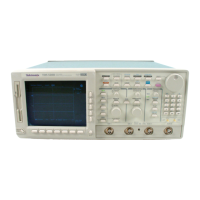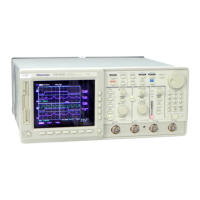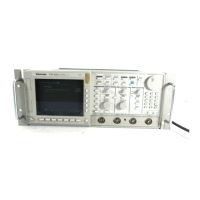Typical Characteristics
TDS 520A, 524A, 540A, & 544A Service Manual
1Ć23
TableĂ1Ć15:ăTypical Characteristics Ċ Triggering System
Name Description
Accuracy, Trigger Level or Threshold,
DC Coupled
Trigger Source
Any Channel
Auxiliary
(TDS 540A &
544A only)
Accuracy
2
±(2% of (Setting - Net Offset) + 0.3 div volts/div
setting + Offset Accuracy)
±(6% of Setting + 8% of pĆp signal + 100 mV)
Input, Auxiliary Trigger
The input resistance is 1.5 kW; the maximum safe input voltage is
±20 V (DC + peak AC).
Trigger Marker Position, Edge TriggerĆ
ing
Acquire Mode
Sample, HiĆRes, Average
Peak Detect, Envelope
TriggerĆPosition Marker
1,2
±(1 WI + 1 ns)
±(2 WI + 1 ns)
Holdoff, Variable, Main Trigger Minimum: For any horizontal scale setting, the holdoff is
10 times that setting, but is never less than 1 ms or longer than 5 s.
Maximum: For any horizontal scale setting, the holdoff is at
least 2 times the minimum holdoff for that setting, but is never more
than 10 times the minimum holdoff for that setting.
Width, Minimum Pulse and Rearm, for
Logic Triggering or Events Delay
3
5 ns
Lowest Frequency for Successful OpĆ
eration of Set Level to 50%" Function
30 Hz
Sensitivity, Edge Trigger, Not DC
Coupled
4
Trigger Coupling
AC
Noise Reject
High Frequency Reject
Low Frequency Reject
Typical Signal Level for
Stable Triggering
Same as DCĆcoupled limits
5
for frequenĆ
cies above 60 Hz. Attenuates signals beĆ
low 60 Hz.
Three and one half times the DCĆcoupled
limits.
5
One and one half times the DCĆcoupled
limits
5
from DC to 30 kHz. Attenuates sigĆ
nals above 30ĂkHz.
One and one half times the DCĆcoupled
limits
5
for frequencies above 80 kHz. AtĆ
tenuates signals below 80ĂkHz.
Sensitivities, LogicĆType Trigger/Events
Delay, DC Coupled
6
1.0 division, from DC to 100 MHz with a minimum slew rate of
25 divisions/ms at the trigger level or the threshold crossing.
Sensitivities, PulseĆType Runt Trigger
6
1.0 division, from DC to 200 MHz with a minimum slew rate of
25 divisions/ms at the trigger level or the threshold crossing.

